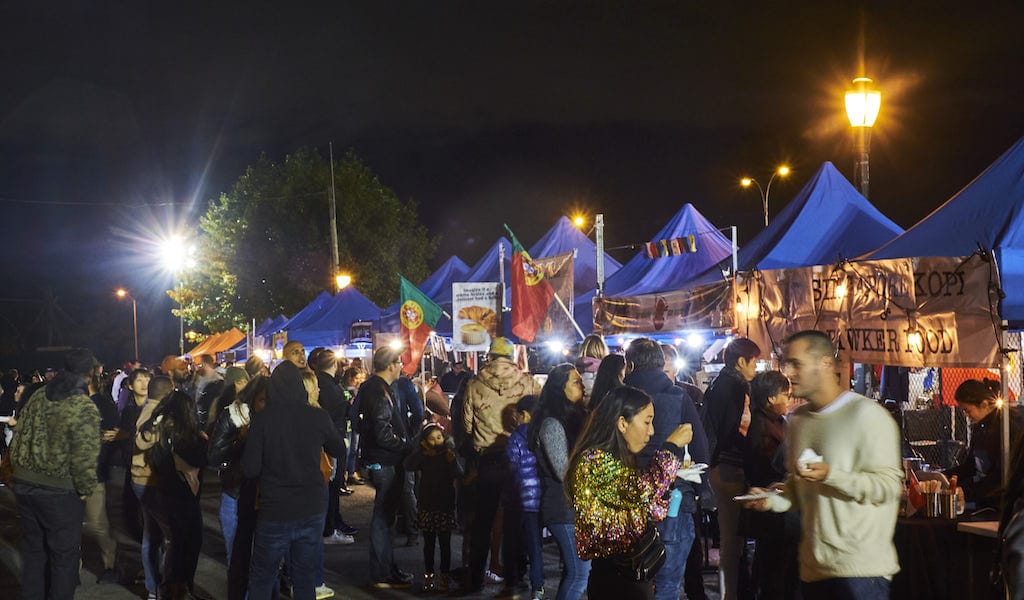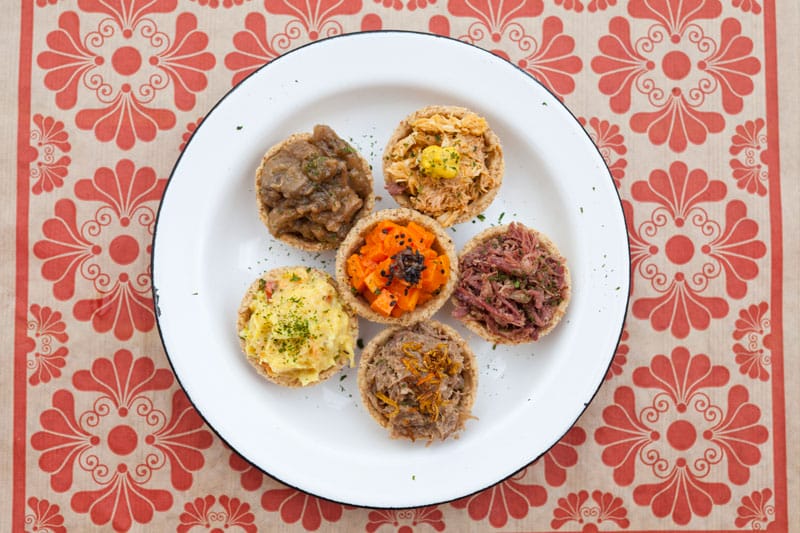Since its founding in 2015, the Queens Night Market has inspired a thrill in the borough and beyond, one that – for us at least – calls to mind boundless childhood summers. Running Saturday nights from April to October, it brings vendor-chefs together from over 80 countries for the community to gather and celebrate with great food.
While the pandemic has put the 2020 season on indefinite hold, this spring fortuitously saw the release of the official Queens Night Market cookbook, The World Eats Here: Amazing Food and the Inspiring People Who Make It at New York’s Queens Night Market (The Experiment; May 12, 2020). Co-authored by Queens Night Market founder John Wang and Storm Garner, a filmmaker and oral historian, the cookbook showcases 88 diverse recipes directly from Queens Night Market’s vendor-chefs, many of whom are first- and second-generation immigrants.
We spoke to John and Storm about the making of the cookbook, the decision to include the vendor-chefs’ oral histories, the effects of the pandemic on the market and more.
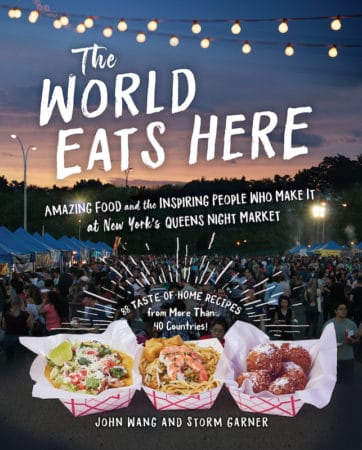 Can you briefly describe the Queens Night Market and your aims for it? And how does this cookbook fit in with those goals?
Can you briefly describe the Queens Night Market and your aims for it? And how does this cookbook fit in with those goals?
John Wang: The Queens Night Market is an open-air, nighttime market that highlights the cultural and ethnic diversity of Queens and NYC. The goal is to be NYC’s most diverse, accessible and affordable community space. Towards that end, we introduced a unique $5 price cap on all the food sold at the event when we debuted in 2015 – although we now have some $6 exceptions. Since it launched five years ago, the Queens Night Market has welcomed over a million visitors, helped launch over 300 brand new businesses in NYC and represented over 90 countries through our vendors and their food.
The Queens Night Market celebrates the cultural diversity of NYC through our vendors and their stories, and the cookbook continues that celebration, especially when the Night Market isn’t operating – as it isn’t now, in the current pandemic. The book showcases 88 vibrant and diverse recipes directly from Queens Night Market’s vendor-chefs representing cuisines from over 40 countries. The recipes are paired with a portrait and a personal narrative adapted from Storm’s oral history interview with the recipe’s creator, or sometimes the chef’s spouse or child who started the business to showcase a family member’s talent, painting a multidimensional collective portrait of small family-run food businesses in Queens and NYC today.
Can you tell us a bit more about this oral history project? How and why did you decide to incorporate it into the cookbook?
Storm Garner: I started the Queens Night Market Vendor Stories Oral History Project in late 2018, while studying in Columbia University’s Oral History MA program, in hopes of documenting for the historical record a bit of what makes the Queens Night Market such a special place to be: the incredible diversity of life paths that cross there, spanning the whole globe and many walks of life. I knew the Queens Night Market food vendors had personal insights – into regional cuisines, American immigrant experiences, entrepreneurship and the food business in New York today – that might be valuable not only to future historians, but to anyone curious to listen today, and to their food businesses, too. I conducted 50 2-4 hour video-recorded open-ended interviews that first year.
While my ultimate goal was to get all the interviews in the project permanently archived, transcribed, indexed and publicly accessible online for educational purposes (at the Nunn Center for Oral History), I also wanted to make sure the vendors benefited from sharing their stories in the short term – that their stories could help their businesses attract new customers. John had been mulling over a cookbook idea for a while and it seemed the perfect opportunity for us to team up, to include stories and transcript excerpts from the vendors’ oral histories alongside their recipes in the book. It’s so much easier to try unfamiliar dishes when you have some personal connection to the chef, when you understand what the food means to them. I hope these stories alongside the recipes will arouse readers’ curiosities and inspire them to dig even deeper on their own!

Over 300 food vendors have participated in the Queens Night Market. What criteria did you use to decide which vendors would be included in the cookbook?
JW: For the most part, it was an open call for Queens Night Market food vendors to participate in the cookbook. Aside from some practical considerations, such as having too many recipes from the same category or from the same region or calling for specialized equipment, the opportunity was open to virtually any vendor who wanted to share their story and their recipes.
The cookbook shares the same goal as the vendor curation process for the Night Market: We want to celebrate NYC’s diversity by highlighting dishes that our vendors have a deep cultural and personal connection to and telling those stories.
Did you face any challenges when it came to getting the recipes down on the page?
JW: The dishes in the book represent family traditions, cherished personal memories, tributes to parents or grandparents, special occasions or cultural staples… but in most cases, the recipes were being documented for the first time.
Working with vendors to standardize their recipe measurements and steps on paper for the very first time was definitely a challenge. For instance, Storm discovered in her interviews that, for as long as anyone could remember, one of the Latinx vendors has been using Chinese restaurant take-out containers to measure out ingredients for her dish. It was basically like “one large plastic soup container of this, one large container of this, one small plastic soup container of that…” Helping the vendor translate that into a standardized recipe took some work!
The recipes in the book also capture just a snapshot in the life or evolution of a dish. Vendors were quick to point out that the way they make the dish often changes with their mood or the season, and that personal touches have been made as the recipe has been passed down through the generations.
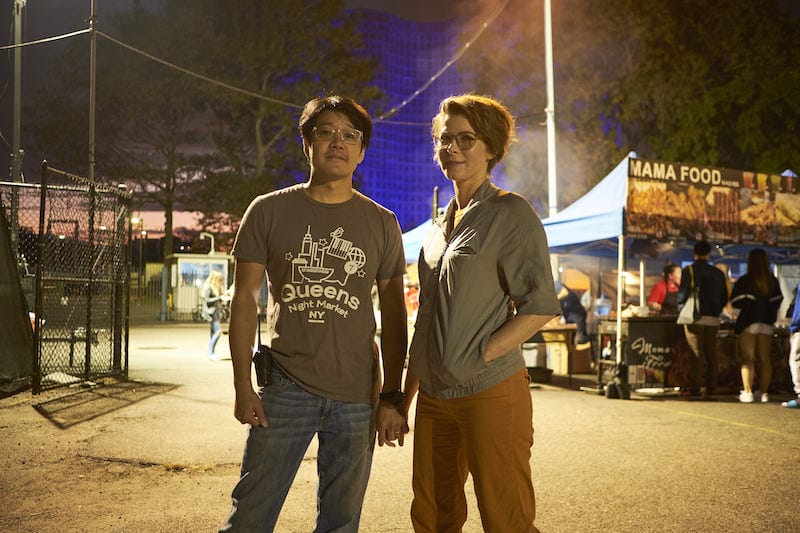
What’s the status of the 2020 Queens Night Market, in light of the pandemic? Assuming that you won’t be able to open this season, are you undertaking any other initiatives to keep the Night Market spirit going?
JW: The Queens Night Market is indefinitely postponed, and of course the later we get into the summer, the more likely that this season will just become a footnote. We’ve been looking at various options for reopening, but every safe solution so far would really chip away at the spirit and the experience of the event: one-way pedestrian traffic, not being able to share a table with strangers, all the social distancing between vendors and visitors, etc.
Equally important is that we don’t set up our vendors to lose money. Given the price cap on food at the Queens Night Market, and unlike at other events in NYC, vendors’ ability to profit critically depends on volume. A limit on attendance would really jeopardize that ability.
We’ll keep exploring the possibilities, but it’s important to us not to compromise the vendor or visitor experience.
The Queens Night Market has been keeping busy in other ways. From April through June, we concentrated on Fuel the Frontlines, an initiative by the Queens Night Market, the Queens Borough President, and the Queens Economic Development Corporation. We raised money to hire Queens Night Market vendors and local businesses to provide fresh meals to healthcare workers at all nine Queens hospitals and seven EMS stations. Over the program’s duration, we collectively raised over $100,000 and provided over 15,000 meals to those bravely working on the frontlines to keep us all safe.
I am also on the Steering Committee of the Coalition for NYC Hospitality & Tourism Recovery, which is focused on engaging, mobilizing and championing all sectors of the NYC visitor economy. And most recently, I am co-chairing the Committee on Food and Economic Security, part of the recently formed Elmhurst/Corona Recovery Collaborative.
SG: Since April I’ve been conducting a second round of oral history interviews with Queens Night Market vendors – remotely now of course – focused this time on how they’ve been affected by the pandemic, both as small food business owners and in their personal lives. These interviews will be donated to the Queens Memory COVID-19 project – a wonderful community history endeavor in Queens, in addition to their archival with last year’s interviews at the Nunn Center for Oral History at the University of Kentucky.
Anything else that you think our readers should know?
JW & SG: We encourage people to continue supporting our vendors and local businesses however they can. Sadly, we know many businesses won’t make it through the pandemic. But everyone can help to some extent by getting delivery or take-out, ordering online, or even just learning about their food and spreading the word!
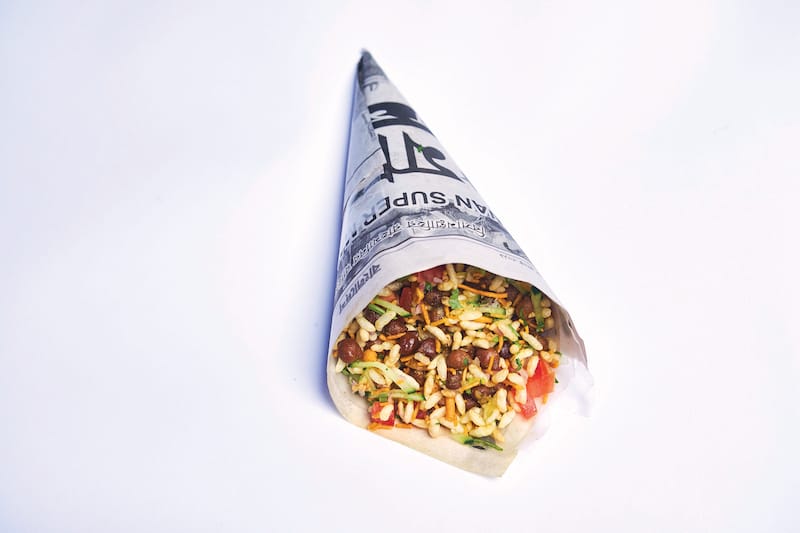
Recipe: Jhal Muri
Spiced Puffed Rice Snack, a Recipe from Mahfuzul Islam of Jhal NYC
When Mahfuzul is vending at the Queens Night Market, he’s really teaching. When he sets up his tent, he hangs a picture of the great writer and artist Rabindranath Tagore, stacks his little information sheets on the table, and prepares to answer any questions his hungry customers may have about the food in such a way as to really give them access to Bengali culture.
A professor of Asian American studies, sociology of religion, and macroeconomics by day, he started Jhal NYC with his cousin both to educate the New York public about Bengali culture – and street food! – and to raise money to benefit his Queens-based Bengali community. The endeavor has already provided the funds for a Bangladeshi girl to go to college.
Mahfuzul was born and raised in Queens in a family-oriented Bengali Muslim household with lots of cousins around. In the summer of 2015, he was back in Queens on summer break from Harvard grad school, and his home was full of family, mourning the loss of an aunt. Mahfuzul wanted to get his bereaved cousin out of the house for a bit. So the two cousins wandered over to the Queens Night Market on a whim. Delighted with the whole scene, and seeing only one South Asian vendor, they started dreaming up their own food stall in giddy what-ifs.
A few days later, those daydreams had turned into feasible plans that would benefit everyone they could think of involving. They split practical tasks (such as applying for licenses), persuaded their talented mothers to oversee the culinary production, and quickly founded Jhal NYC to bring New Yorkers the Bengali street food you simply can’t find in restaurants.
Before grad school, Mahfuzul had worked in sustainable development at the UN and hoped to enter the foreign service to make use of his intimate knowledge of two very different cultures and ways of life. Now, running Jhal NYC has provided him a launching pad for his own sort of independent, sustainable, development- oriented diplomatic mission – developing innovative teaching materials around food and intercultural storytelling – and, of course, the opportunity to share delicious Bengali food New Yorkers for too long have missed out on.
******
Jhal muri is cheap, quick and easy to make, especially if you make the tempered oil in advance. Mahfuzul can’t think about jhal muri without being reminded of the sounds of the bustling streets of Dhaka. It’s traditionally served in a newspaper cone, and with the component spices all laid out in individual bowls, it can be easily customized to each person’s tastes.
Makes 1 Serving
Tempered Mustard Oil
1 small yellow onion, roughly chopped
4 garlic cloves, roughly chopped
3-inch (7.5 cm) piece peeled fresh ginger
4 cups (960 ml) mustard oil
1 1⁄4 teaspoons ground coriander
1⁄4 teaspoon ground cumin
Scant 1⁄4 teaspoon Indian red chile powder (lal mirch)
Scant 1⁄4 teaspoon turmeric
2 cardamom pods
1 cinnamon stick
1 bay leaf
Jhal Muri
3 cups (45 g) puffed rice
1 cup (about 60 g, depending on the brand) chanachur (Bengali seasoned snack mix, can be purchased at any South Asian grocery store)
2 tablespoons chopped cilantro
1 tablespoon diced tomatoes
1 tablespoon diced onion
1 teaspoon thinly sliced green Thai chile, with seeds
Juice of 1 lemon wedge
To make the tempered mustard oil, combine the onion, garlic, and ginger in a food processor or blender. Blend into a smooth, uniform paste, adding water, a teaspoon at a time, as necessary. Combine paste with all the remaining ingredients in a large saucepan over medium heat and bring to a rolling boil, about 10 minutes. Remove from the heat, set aside, and store any excess in a glass container in the refrigerator for future use. There is no need to strain out the solids.
To make the jhal muri, pour the puffed rice and chanachur into a large sealable container such as a bowl or jar with a lid. Add all the remaining ingredients, as well as 1 tablespoon of the mustard oil, and shake vigorously so that the puffed rice and chanachur are evenly coated by the wet ingredients.
Serve in a newspaper cone for a traditional presentation, or otherwise in a large cup or a bowl. Eat with a spoon.
Recipe from Mahfuzul Islam, Jhal NYC. Excerpted from “The World Eats Here: Amazing Food and the Inspiring People Who Make It at New York’s Queens Night Market,” © 2020 by John Wang and Storm Garner. Photographs © by John Taggart. Reprinted by permission of The Experiment. Click here to purchase your copy. John and Storm encourage readers cooking their way through the book to post about their experience on Instagram by tagging both @QueensNightMarket and @TheWorldEatsHereCookbook.
 June 24, 2015 Wuyuan Bingjia
June 24, 2015 Wuyuan Bingjia
When Wuyuan Bingjia first opened in 1936, it was one of many Shanghai-style bakeries […] Posted in Shanghai January 14, 2019 Going Deep
January 14, 2019 Going Deep
As the calendar year turns over, we’ve grown accustomed to the barrage of lists telling […] Posted in Tbilisi, Special category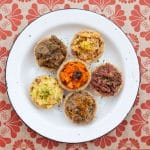 August 19, 2016 Santa Filomena
August 19, 2016 Santa Filomena
Like the classic optical illusion of the faces and the vase, look at Rio and you’ll see […] Posted in Rio
Published on July 24, 2020
Related stories
June 24, 2015
ShanghaiWhen Wuyuan Bingjia first opened in 1936, it was one of many Shanghai-style bakeries around town, churning out trays of benbang dim sum dishes to be eaten on the go or taken home and enjoyed with the family. Now, as the city grows skyward and Shanghainese palates skew more international, these old-style bakeries are slowly…
January 14, 2019
Special category | By Culinary Backstreets
Special categoryAs the calendar year turns over, we’ve grown accustomed to the barrage of lists telling us where to travel during the next 12 months. Oftentimes these places are a country or even a whole region – you could spend an entire year exploring just one of the locations listed and still barely make a dent.…
August 19, 2016
RioLike the classic optical illusion of the faces and the vase, look at Rio and you’ll see two sharply contrasting versions. First is the seemingly easygoing beach city of rubber sandals and gushy greetings as insincere as they are well intentioned. (“Passa lá em casa!” “Come by my home!” The carioca will actually be quite…







































